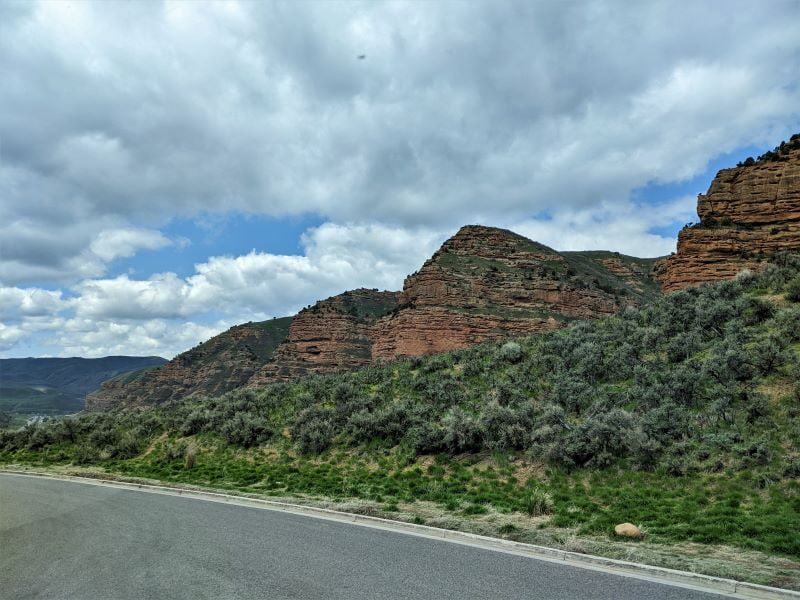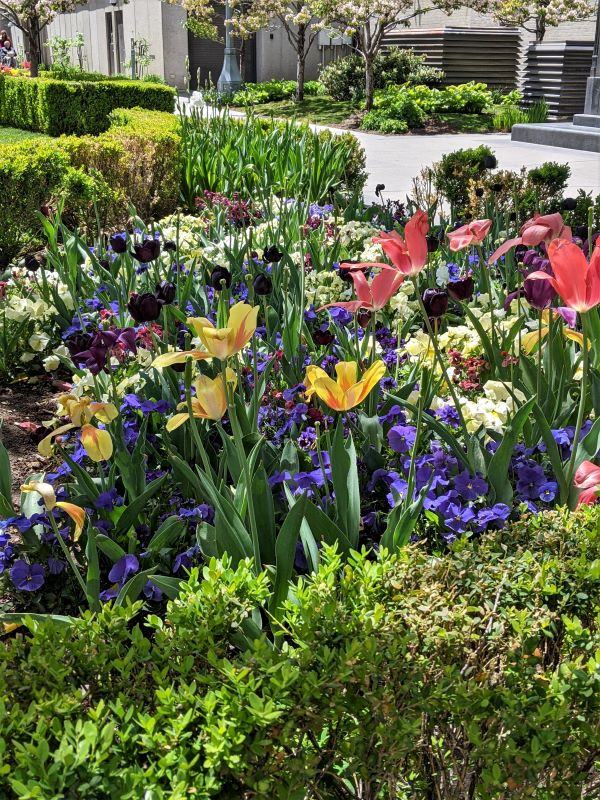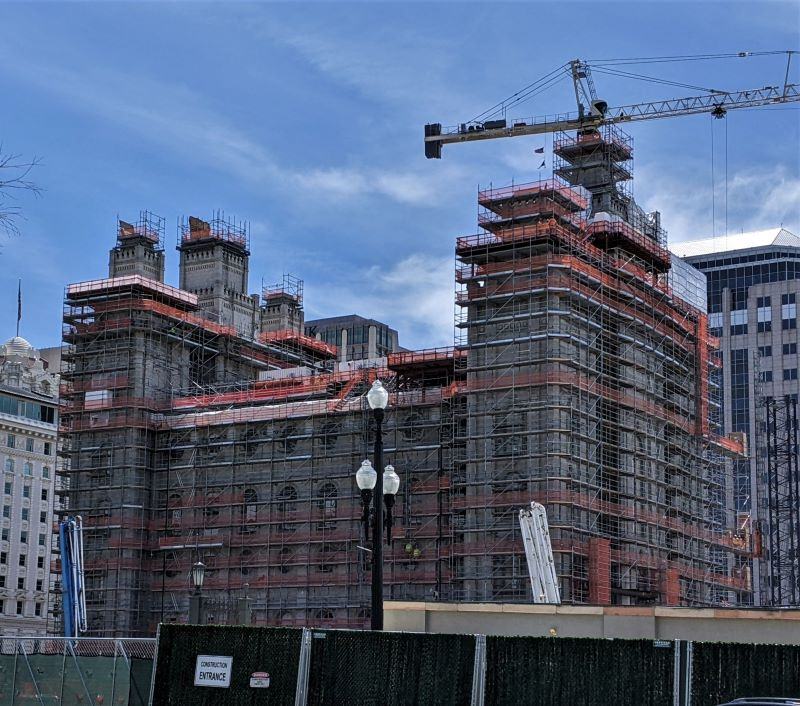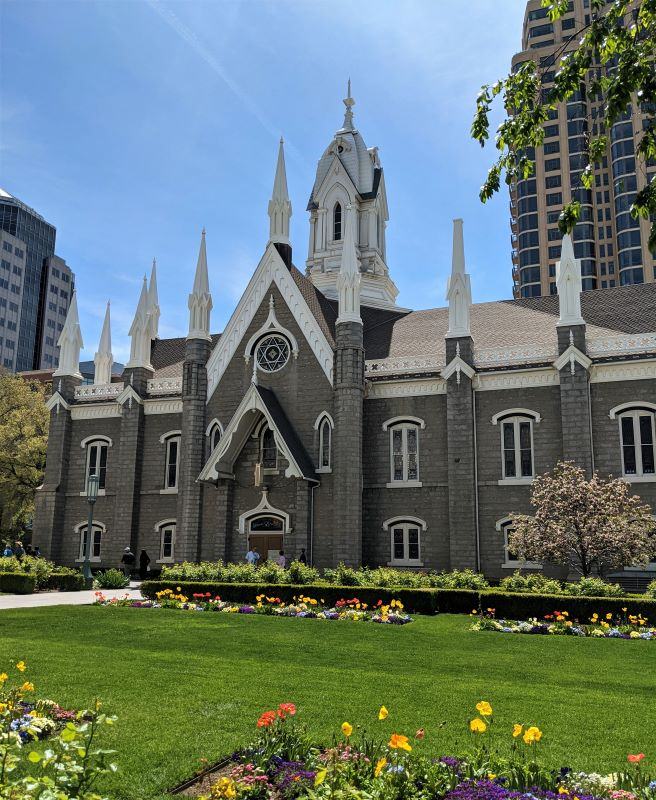We stopped in Salt Lake City on our way west. Starting in Fort Bridger, we (almost) followed the Mormon trail to Salt Lake City. I say almost because starting in Echo Canyon, the Mormon pioneers took a different route. From Echo Canyon, we followed the Weber (Wee-ber) River, through Weber Canyon, and then to Ogden.

Another Reroute
Staying at Hill Air Force Base represented another reroute for us. This spring represented plenty of that activity. I had planned to stay in the “Valley” at Anderson Cove Campground near Huntsville. This time we didn’t reroute because of the cold or the wind. But as you can see from the pictures, it was still plenty cold enough.
“The Valley” as locals call it represents Nordic Valley on the east side of Mount Ogden. Ogden and Hill Air Force Base is on the west side of Mount Ogden. The east side of the mountain is considered “the valley”. Ogden is on the west side, sandwiched between The Great Salt Lake and Mount Ogden. Ogden is just north of Salt Lake City.
The California Trail
As I mentioned, the Mormon Pioneers didn’t take the Weber Canyon route. The Mormons also didn’t follow the route through Parley’s Canyon which was further south. This is because Lee Hastings (an early promoter of California and the California Trail) recommended the Emigration Canyon Trail route to the Donner Party. (I will explain how the Donner party fits into the story later.)
Weber Canyon is to the west of Echo Canyon. The Mormon Trail Emigration Canyon route turns to the south just past Echo Canyon and then crosses Big Mountain Summit. From there the Mormon Trail descends Emigration Canyon leading to Salt Lake City. For the pioneers, this meant crossing over the top of one last mountain before descending into Salt Lake City.

The “official route” of the California Trail followed the route of the Oregon Trail starting at Fort Bridger and then across southern Idaho. This followed the Snake River rather than a waterless trek across the Utah and Nevada desert. I have a nice description of Fort Bridger in this post. Across Wyoming
Rather than going north from Fort Bridger, Lee Hastings preferred a route through present-day Utah near the Great Salt Lake and then across Nevada. Hastings expected this route (now called Hastings Cuttoff) to shave weeks off the trip. The current route of Hastings Cuttoff follows current-day Interstate 80. The Hastings Cuttoff didn’t work well for the Donner Party.
The Donner Party
The use of Emigration Canyon by the Mormons for their entrance into the Salt Lake Valley was based on the work of the Donner Party. Yes, that Donner Party. The Donner Party is famous in California history. Even though Weber Canyon would have worked, Lee Hastings recommended Emigrant Canyon.

Cutting their way across Big Mountian Summit took most of August for the Donner Party. It was far more difficult than expected. Thus the Donner Party arrived in California late in 1846 just in time for a huge blizzard. They were snowed in, on Donner Pass north of Lake Tahoe, making history. If you don’t know the story here is a link: Donner Party Anyway, a late start, Hastings, and the delay in Emigration Canyon set up the Donner Party’s problems.

The Mormons
A year after Hastings and the Donner Party, the Mormon party entered Echo Canyon. They had two choices, either Weber Canyon or a brand new road hacked across Big Mountain by the Donner Party. Most of the route was already cut by the Donner Party. Since the Mormons benefited from all the work of the Donner Party they entered the Salt Lake Valley with enough time to plant crops hoping for a harvest before the end of the year.

This is the place
Upon exiting Emigration Canyon, Brigham Young announced the end of the Mormon journey. Just to the west of Emigration Canyon is the location of downtown Salt Lake City. Just to the north of downtown is the first Mormon Temple Square.

Temple Square
Temple Square is the main attraction in Salt Lake City (especially for Mormons). Brigham Young dedicated the location after their arrival in 1847. The layout of the Temple (and Temple Square) hasn’t changed very much since its design and construction in the late 1800s. The biggest change is currently in progress. The temple is getting a makeover, starting from way below the ground.

Earthquake proofing
The plan is to make the Temple earthquake-proof. Obviously, in the late 1800s, the designers didn’t know or couldn’t have known how much risk the temple (designed as a gothic cathedral) would be in during a major earthquake. So when we were there, the entire building was covered with scaffolding, and a huge pit was dug around the foundation of the temple. Under the foundation, massive “rollers” are being installed to allow the building to shift during an earthquake without destroying the building.

Next to the Temple building and still open during our visit were the other buildings on the Temple Square. I had not visited these since I was a child. Both the Assembly building and Tabernacle buildings are open and still very beautiful. I understand that for a short time, the Mormon Temple in Salt Lake City will be open to the public after the construction is finished. After that, just like before the construction, the Temple is only open to Mormons.

Family and Friends
For us, we didn’t travel to Salt Lake City to follow the Mormon Trail and didn’t know the connection to the Donner Party. We also didn’t come to see the Temple and didn’t know it was being retrofitted to make it earthquake-proof. We came to Salt Lake Valley to see family and friends. It was really good to see everyone.

Please subscribe and join us on our journey
We will add you to our email list and send you updates about once a week. Here is a link. Subscribe


Very nice post
I always learn something new and unexpected in every post. Who knew that there was a connection between the Donner Party and the Mormon Trail?
These pictures are stunning.
There’s something about the sky in Utah that is just magical. It’s so incredibly blue. I love it. And especially when it’s set off against those snow capped mountains? Wowzers, for sure!
Interesting to hear they are retrofitting the church to withstand earthquakes. I can’t even imagine how complicated that kind of project must be, but there’s a reason Japanese buildings routinely withstand earthquakes. they’ve been doing this kind of stuff for years and it really works. Amazing stuff.
Ogden is on our list for next spring. Thanks for the input on what to see.
Brook and Joe
I always love pictures of the Donner Picnic Area in the national forest! Thanks for the post and history lesson. Pictures of the cold and snow are welcome during this heat wave! Stay cool!